FAQs on Parrot, Jelly-Bean... Cichlids, Disease/Health 1
FAQs on Parrot Disease:
Parrot
Cichlid Health 1, Parrot
Cichlid Disease 2, Parrot Cichlid Disease
3, Parrot Cichlid
Disease 4,
FAQs on Parrot Cichlid Disease by Category:
Diagnosis,
Environmental,
Nutritional (e.g. HLLE),
Social,
Infectious (Virus,
Bacterial, Fungal), Parasitic (Ich, Velvet...),
Genetic,
Treatments,
Related Articles: Blood Parrots & Flowerhorn
Cichlids: maintenance and healthcare of two popular hybrid
cichlids by Neale Monks, Neotropical Cichlids, African Cichlids, Dwarf South American Cichlids, Cichlid Fishes in General,
Related FAQs: Parrot Cichlids 1, Parrot Cichlids 2,
&Parrot
Cichlid Identification,
Parrot Cichlid
Behavior, Parrot Cichlid
Compatibility, Parrot Cichlid
Selection, Parrot Cichlid
Systems, Parrot Cichlid
Feeding, Parrot Cichlid
Reproduction,
|
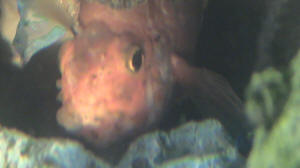
|
|
Parrot Fish, hlth. 9/28/08
Hello, <Hello,> I have had a parrot fish for about a year
now, in a 55 gallon tank with a Tiger Oscar, Jack Dempsey,
another parrot, a Firemouth and Green Terror. We have a Dracula
Pleco as well. <Not enough space for all these fish; they will
fight, likely also have problems maintaining low nitrate
concentration for long term success. If you have more than 20
mg/l nitrate in this tank, you're running a real risk of a
Hexamita outbreak.> About 7 days ago, his face on one side
started to swell and look puss-filled, then white bumps formed
like pimples. (See pics). <Bacterial infection, like Finrot
and/or Columnaris. Will need to be treated appropriately. Do
understand that these infections are almost always related to
environmental issues, so do review water chemistry and quality.
Treatment without correcting the environmental issues that caused
the disease in the first place won't deliver long-term
results for obvious reasons.> We went to the aquarium shop and
they said he might have bumped into something and it got
infected, so they gave us KanaPlex antibiotics. We have dosed the
tank for 4 days and have not seen much improvement. He is acting
normal, but didn't eat for a few days. He's eating again
now. <Would recommend Maracyn first, and if no improvement
after one full course, switch to Maracyn 2.> Thanks for any
help. We check our water regularly, vacuum every 2 weeks, change
our filters every 4-6 weeks and feed pellets twice a day. <Too
many fish with too different requirements in terms of water
chemistry... this aquarium has the potential to go wrong in lots
of ways. Do research the needs of each species, and then
concentrate on providing those conditions for a subset of the
fish you have, and get rid of the others. Cheers, Neale.>
|
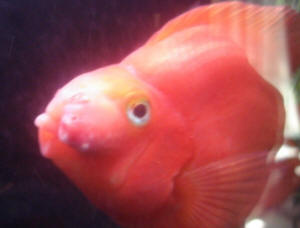 |
Parrot Cichlid With Swim Bladder Problem 9/9/08
Good day! I was checking the site to look for similar problem as my
parrot fish, Some are same but no mention of the weird way of drop
landing and staying on the ground nesting-like attitude. About 5 years
ago my friend gave me a blood parrot, because he has this heart shape
tail and its really cute. At first I thought it would be extra burden
to care for fish because I don't know much about them compared to
dogs where in I have 4. So far over the years he was alright, but last
June he got really sick. I could tell because he has this while cotton
like around his fins and he doesn't swim much. He stays on the
ground, doesn't eat and struggles to swim up to the surface just to
catch some air. H also swims upside down, also probably common to
parrot fish when they really sick. So I got really worried, went to a
pet store and bought this SERA BAKTOPUR. I changed the water and
treated it with the Baktopur, after 2 days I changed the water again
then treated it. I stopped the treatment as per instructed by the box
label then two days after I just changed it to clean water. He was
alright after a month, he was back again! He plays with me. Again when
I stick the food to my finger he would slightly surface up to get it on
my finger tip. So that's his past. Just recently, like 4 days ago,
I noticed that he stays on the ground a lot, he swimming is funny
because he just swims around for a second then drops to the ground like
he couldn't do a perfect landing. This is really really weird. He
eats fine, still plays with my finger when I'm feeding him. If I
pass by the aquarium he recognized me though and swims to the corner,
so other than the swimming problem and the bad ground landing he is
fine. I just want to treat it before it gets worse or progress to more
scary disease. Please HELP
ps: Can I still use the Sera Baktopur to treat my parrot fish? The
label says water treatment against mouth and fin rot and bacterial
infections in freshwater aquariums. Symptoms of bacterial disease are
white to grayish spots, blood spots and sores on the skin, also
infections on and around the fish anus and on the edges of the fins.
Dropsy, recognizable by the protruding of scales, a bloated body and
bulging eyes. a cotton wool like fluff around the mouth, White-gray
nodules on the head and fins and an agitated swimming motion at the
bottom of the aquarium. White edges of the fins and sometimes complete
destruction of the fins.
Direction: 1st day: 22 drops or 1 ml per each 20 liters
2nd day no treatment
3rd day 22 drops or 1 ml per each 20 liters
Composition:
100 ml sera Baktopur contain,,,
Acriflavine 209.7 mg
Methylene blue 4.95 mg
phenylglycol 0.6 g
aqua purificata ad 100 ml
Please let me know if its alright to still use this, to treat my
parrot...
Thank you Worried-Doris
< I would first try and improve the conditions of the aquarium.
Start by doing a 50% water change, vacuum the gravel and clean the
filters. I would raise the water temperature to 82 F. I would recommend
treating with a combination of Metronidazole and Nitrofuranace. If
these are not available I would try Clout. -Chuck>
Parrot Cichlid With Swim Bladder Problem II
9/11/08
Hi Chuck, Thank you for the quick reply. Actually I just checked the
mail right after I cleaned my tank. Regarding the Metronidazole and
Nitrofuranace that you mentioned or Clout. Where can I get this
medications? Are this medications the kind of over the counter drugs?
Because I went to a fish store they don't have those medications.
What is common here in the Phils are the Sera products, really worried
here. Thank You - Doris
<I saw your photo in the last reply and my recommendation is the
same. In the USA these medications may be found at local fish stores or
online through DrsFosterSmith.com. Check with a vet for the
Metronidazole (Flagyl) and use a Furazone type of antibiotic that I am
sure Sera sells.-Chuck>
Blood parrot swim problem
4..
Treating Parrot Cichlid With Metronidazole 9/11/08
Hi again, which is better Metronidazole in the water, or with the food?
If with food, how much should I give? What I'm giving is the
floating foods (the one with red and greed colored circles). Can I get
instructions on how to add with the food and how much should I give.??
Thank you again-Doris
<Add 1/2 teaspoon of Metronidazole to 4 OZ of food. Dampen the food
with water, add the medication and roll it into a little ball. Break
off pieces and roll them into bite size little balls and feed right
away. Freeze the rest to be fed later. Remove any uneaten food after a
couple of minutes.-Chuck>
Re: Feeding Metronidazole To
Sick Cichlids 9/14/08
Hi Chuck, copied that instruction already, tnx. Is this ones a day
intake? What reactions will the fish have that I should not be worried
at all when taking this med? How many mg should I buy for the
Metronidazole Flagyl?? When everything is already consumed, that will
be the end of the medication?? Will it really fix the swimming bladder?
What's the connection with salt intake as what I've read
somewhere, or if electrocuted?? Thanks again Chuck...-Doris
< Get four oz of a frozen food that your cichlid loves to eat.
Defrost the food and ad a 1/2 teaspoon of Metronidazole and mix well.
Refreeze the food. Feed it to your fish for 10 straight days. No real
side effects. If he stops eating then you need to treat the water. The
success of the treatment depends on how rapidly you add the medication
to the diet. Keep the water clean. Salt will make the fish drink a
little more. So if the medication was in the water then he would ingest
some medication while he is drinking. Adding salt will add electrolytes
to the water and make the water a better conductor of electricity. Pure
fresh water has no electrolytes so it is a very poor conductor of
electricity.-Chuck.>
Problem with Red Parrot fish 9/9/08
Hi Bob
<It's Neale this morning.>
You recently advised us on a 'swim bladder' problem with a Red
Parrot fish (see e-mails below) and we wondered if you could help us
with another problem with our largest Red Parrot 'Pinky'
<My least favourite fish on the planet I'm afraid, but will do
my best. Do understand these things are grossly deformed hybrids prone
to all kinds of diseases and syndromes because of it. They aren't
easy to keep and certainly aren't suitable for beginners to the
hobby.>
About 3 weeks ago we noticed that Pinky had developed a small lump on
the side of her mouth and a week later it had grown into a large red
lump about 3mm across. We have treated the tank with 2 doses of
anti-bacterial infection solution but the lump is still there and she
has now gone very pale and off her food, today I also noticed that she
had a few white spots on her body and fins
<The "lump" could be a variety of things. In cichlids
generally, fighting often takes the form of mouth tugging, and because
Blood Parrots have the aggression of Central American cichlids but not
the stamina or strength, they easily lose out. Their weaker immune
system means that light damage doesn't heal so quickly, and poor
water conditions will make things worse. Despite being sold to
inexperienced fishkeepers as funky pets, these are fundamentally large,
Central American cichlids that need systems measured upwards of 180
litres/50 US gallons to thrive. Like any cichlid, water quality must be
excellent, in particular zero ammonia and nitrite. In common with
Central American cichlids they are somewhat adaptable with regard to
water chemistry, but soft/acidic conditions must be avoided. My guess
is that this fish injured its jaws, and you have something like Mouth
Fungus (actually a bacterial disease) or Finrot setting in. Easily
cured using suitable medications. In the UK I'd recommend a brand
called eSHa 2000, which is safe to use in combination with eSHa EXIT,
the manufacturers Whitespot/Ick medication. No cure will work if the
fundamental problems with the tank aren't corrected as well, so
review these. Tell me more about your tank, the other fish in the
system, what filter you use and I can comment further if
required.>
I know that the 'white spot' can be treated as we have had to
treat it before but don't know what the other conditions could be
and how to treat them - I am very unsure about putting too many
treatments in the tank and subjecting the other fish to too much
stress
<Medications are only safely used in combinations if expressly
stated as such by the manufacturer (or a vet). Do also remember to
remove carbon if you were tricked into using that stuff in your
freshwater aquarium (for most freshwater tanks the stuff is redundant
assuming decent filtration and weekly 25-50% water changes).>
Mark & Sam
<Cheers, Neale.>
Re: Problem with Red Parrot fish 9/13/08 Hi Neale Thanks for coming
back to me <You're welcome.> We tried to get hold of some of the treatment you
suggested but it is proving very hard to local someone local who has heard of it
and can source some for us <Try online. eSHa products are widely sold.> We have
however just finished our 2nd bacterial treatment and replaced the media in the
filter (inc carbon I'm afraid although I am considering not bothering once the
fish are better) <Do understand carbon MUST be removed while treating the fish.
Carbon absorbs (or more precisely adsorbs) organic chemicals such as dyes, and
this renders any treatment useless. One of many reasons I recommend against
using carbon in the average freshwater aquarium.> We also did a 30% water change
and the sore on Pinky seems to have started to heal and although she still
doesn't have an appetite the other fish have and she is starting to chase the
other fish around again <Good.> We have however noticed that the other parrots
fins have started going black!! <This may be normal. Many Blood Parrots have
speckled/mottled fins. A photo would help.> Any ideas what this could be?
<Provided the fins are entire and show no signs of rot or fungus, I'd not be
alarmed.> Our tank is 240 litres with a Fluval 305 external pump, aerator stone
and houses 1 large(Pinky) and 2 small parrots, a gold Severum, 2 silver dollars
and 2 Plecs Mark & Sam <Cheers, Neale.>
Re: Problem with Red Parrot fish 9/21/08
Hi Neale
<Good evening!>
Just thought I would let you know all our fish are doing great now - we
found out that the pump had become almost completely blocked up (which
it has never done before between full cleans) - once I had cleaned the
pipes out the fish were back to normal within a couple of days
<Well, all's well that ends well! Does sound as if water
circulation was the issue. Do check the pump each time you clean the
filter, which should be every couple of months or so.>
Many thanks for help
<Have fun with your fishies!>
Mark & Sam
<Cheers, Neale.>
Blood Parrot Help -- 8/25/08 Parrot Cichlid
Floats to The Top I have a blood parrot cichlid that has something
wrong with it's swim bladder, it keeps floating to the top and has
trouble staying at the bottom. Is there really a malformation of their
swim bladder? Could this be the problem? Can it be fixed? Will it die?
< The parrot cichlid is a cross between three different cichlids.
They are deformed on the outside to give them that unique body shape
and also have inherited deformities on the inside too. The problem is
probably an intestinal blockage. Bacteria may be feeding at the
blockage and causing the intestinal gas that cannot be released.
Typically I recommend Metronidazole and Nitrofuranace in a hospital
tank. If the fish is still eating then food with Metronidazole in it
will be very beneficial. Some aquarists also recommend Clout too. The
success depends on a quick effective treatment. Delays in treatment
make a complete recovery less likely.-Chuck>
Dark Patches On Parrot Cichlid -- 6/17/08 Hello, I recently
bought a blood parrot and when I put it in my tank it developed Ich. I
treated it and it went away, but a few weeks later it started
developing black around its fin and just thought it was its coloring.
It still acts healthy and today I noticed it has black on his upper lip
and a few black splotches on his back. His normal color is a light
pink. What could this be? He still acts normal. Thanks <The blood
parrot cichlid is a cross between a couple of different cichlids. It
has been selectively bred for it's red coloration. Sometimes the
red coloration is broken up by blotches of darker pigment. Scar tissue
sometimes heals darker than the rest of the body's normal
coloration too. I think that this is just genetics and is nothing to
worry about.-Chuck>
|
Jelly-Bean cichlid 9/29/08
Hello there. First of all, thank you for taking time to help
me!
I have an 9 year old Jelly-bean cichlid named Walter. He's
been doing great up until a week ago. He seemed fine and then one
day started to have rapid gill movement and his color was really
dull. So, I tested the water and did a water change. He seemed
find for a few days and then I noticed next to his left eye it
looked like a black worm on the INSIDE of the scales. I
didn't think anything at first until a day later it went away
and then came back again. Sometimes it looks like it might pop
out of his scales, but then goes back in. Then two nights ago I
noticed his left eye was a little swollen. Its not severe, but
its just enough to notice. (I spend hours with these fish a day.)
He's appetite hasn't changed, and he doesn't seem
lethargic. But I'm worried about that black spot and his eye.
Any ideas? This fish is just like my best friend. I would hate to
loose him... I'm not sure if its important info but, his tank
mate is a HUGE silver dollar and a Pleco. The temp in the tank
stays at 75 degrees. I'm sending you some pics. I hope they
aren't too big... Thank you again!
<Jennifer, please, next time you write, send smaller images!
We do specifically ask people reduce their image sizes to ~500
kb. Your three photos were over 4 MB, and that's a good part
of our e-mail space, running the risk of bouncing back other
peoples' messages because of insufficient space to receive
them. We do ask this at the "front door" where you got
our e-mail address, so please do try and follow our (few, but
necessary) rules before writing. Anyway, it isn't obvious to
me that there's anything seriously wrong with this fish. The
black "worm" is most likely just dead tissue, and along
with any lethargy, excessive gill movement, or swollen eyes are
likely non-specific reactions to some issue with water quality or
water chemistry. To be sure, at 9 years of age your cichlid is
certainly in its "old age" (anything above 10 years is
uncommon with medium-sized cichlids). So broadly speaking I'm
sure you maintain your aquarium well. But do in particular check
the temperature is correct, if there are any unusual pH changes,
and that water quality is good. Old, established tanks often
experience pH drops if you've hitherto relies upon calcareous
media to buffer the pH and create the hard, alkaline conditions
these hybrid cichlids require. Assuming that you have done this,
you may need to remove/replace some of that calcareous media.
Cheers, Neale.>
|
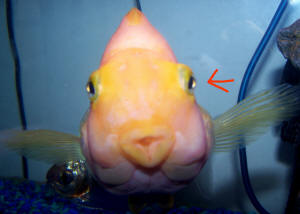
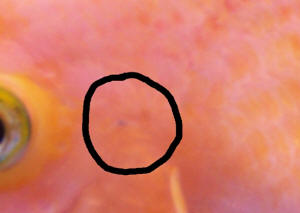 |
| Parrot Cichlid help
05/30/08 Parrot Cichlid With Protruding Gill
Covers I looked into anchor worms and that didn't'
seem to be what he has. I attached some pictures where you
can see what is going on? Like I said, I've treated them
and no change. He seems to be normal in all his activities. Can you
help? < Thanks for the photos. I don't think there is a
parasite problem. Parrot cichlids are a cross between three
different species of cichlids. They have a very unusual body shape
and are actually deformed compared to "normal" cichlids
found in the wild. Some of these abnormalities include stunted
fins, shortened backbones and deformed faces. Since you fish acts
normal in every way I am going to assume that it is a genetic
condition and not a disease. Those red worms may be gill filaments
that have broken off from the rest of the gill
rakers.-Chuck> |
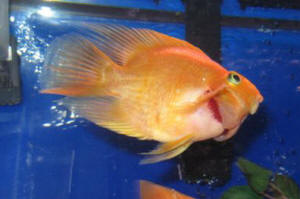 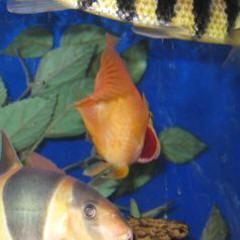 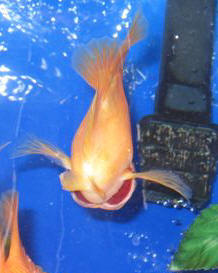 |
Parrot Cichlid With Gourami I have had a Gourami
and Parrotfish for over three years now living in a 20 gallon tank.
The parrotfish has always bullied the Gourami, but most of the time
they get along fine. My parrotfish has been acting very strangely
over the past week - moving the rocks around in the bottom of the
tank (HUGE pile on one side), and today he was swimming up and down
the side of the tank in an agitated manner - I actually think he
tried to "jump out" tonight. My husband also noted the
parrotfish was "attacking" the Gourami the other night.
The parrotfish is showing signs of stress with black marks showing
up on his fins and body. My Gourami hasn't been eating
regularly and I just saw tonight has a single swollen blood-red
eye. I purchased Maracyn 2 for the tank under the guidance of a pet
store worker. I have not tested the ph or the ammonia and the
temperature has spiked in the tank to over 84 degrees - we put the
a/c on in the room to help cool the water down. Should
I try to test the ph and treat the water while I am
using the Maracyn 2? Not sure if I needed that after reading all
the articles on your site, so I don't know if I should stop
treatment and balance the water or do both. Help! Victoria <
Your parrot cichlid has now established the entire 20 gallon tank
as his territory and will defend it from all other fish and
probably from external sources like humans walking by. The injury
is probably from the parrot attacking the Gourami. At 84 degrees
the fishes metabolism is elevated and this could make them more
aggressive. Don't worry about the ph but watch for ammonia
spikes because the antibiotics will probably affect the good
bacteria used to break down the fish waste.-Chuck>
Sick
Gourami What can I do to help out the poor Gourami? His eye
seems to now have "popped" - it's no longer blood
read and clear - there is a tear in the bubble and stringy black
items are coming out. Is this a normal healing process? Should I
move him to his own tank to heal and treat with Epson salt? I am
still using Maracyn - Two and the ph was fine, but as you said, the
ammonia was up... the water temp is 80. Thanks so much for your
help! Victoria Barba < Move the Gourami to his own tank. If you
see exterior signs of bacteria then I would recommend treating with
Nitrofurazone. Internal bacterial infections with not visible signs
of bacteria except the popped eye need to be treated with
Metronidazole.-Chuck> |
Upside Down Parrot Cichlid 7/7/05 I have 4 parrot fish in a
75 gallon tank. I have had the same fish for over 4 years with
virtually no problems. Recently, one of the fish has started hanging
upside down in the plants. He still can right himself, swims
around without difficulty, and eats well. Other than the
hanging upside down, there is nothing unusual. At first I
thought it was a swim bladder problem, or a problem from feeding at the
surface, but it has not corrected itself. The fish store
told me that if he was eating, not to worry. Any suggestions? Thanks
Brenda < If it is an internal bacterial problem then it needs to be
treated with Metronidazole. Other than that it could just be
intimidation from the other fish that has got him hiding.-Chuck>
Discoloration of Jellybean 07/02/05 Hi, I have recently
purchased a pink Jellybean, from the Blood Red Parrot Cichlid family,
<Mmm, not a family but a tweaked cross-breed of the cichlid family
itself> these are the man made fish as you probably know,
and very expensive. I have had her for about 3 weeks
now. She is in a 5 gallon tank by herself. <Too
small...> I have a whisper filter, colored gravel, a fake
plant, and one decoration. Lately she has been turning colors. First
her lip had a black spot on it and now it is jumping around her body
from place to place with large and small areas that are gray
and black in color. She acts healthy and eats fine. I have
asked the LFS where I bought her about this and have
searched the internet trying to find out what's wrong with her, but
cannot find anything. I did have my water tested and it is
fine. <Need actual values... "fine" is of no use>
Please let me know what's wrong so I can get her treated
as soon as possible. Thanks. - Stacy <Is this
system cycled? This is a social dihybrid species... needs to be in a
larger system... Bob Fenner>
Parrot Cichlid Swimming Strangely
6/31/05 I have a 4 year old red blooded parrot. I have purchased
about 6 fish only because I have a 125 gallon aquarium and it was
starting to look empty. I only have about 12 fish in there but for some
reason the female parrot, the one that is 4 has started swimming upside
down, she gets up anytime I get close to the aquarium and is eating
normally, but hangs out at the bottom in a corner upside down. What is
wrong with her, if anything? < Your parrot cichlid may have an
internal bacterial infection. I would isolate her into a smaller tank
and treat her with Metronidazole as per the directions on the
package.-Chuck>
Black patches on parrotfish... FW! Cichlids, poor svc. work
11/4/05 Hello Crew! Firstly, I wanted to let you know how wonderful
your website is--it is a gem! I work for a company that has a
fish tank that is serviced by a local company on a monthly basis. They
do a horrible job--I can't even tell you how many fish have died
since I started working here a year ago. I would guess 50, at least.
Unfortunately, no one who works here is a fish expert and we are sort
of at the mercy of the company who does the monthly cleaning. <Fire
them. Either take over the job in-house or hire a capable company>
We
just went through a horrible Ich problem and lost most of the fish in
the tank, including a lovely parrot fish that everyone adored.
<This family (Scaridae) are not easily kept in captivity His mate
survived the Ich, but she now has many black patches on her body,
including a line that runs right down her back. They look like dirty
smudges and they are not raised like blisters. <Likely "stress
markings" When we called the cleaning company, the owner said that
this is normal and happens to all fish on occasion. <... no... Fire
them>
Of course, since we are mere employees and not fish keepers
ourselves, we cannot really argue with this supposed expert. Do you
have any idea what this is? A fungus? <Evidence of poor care...
toxic, incompatible environment, poor nutrition It is definitely
getting worse each day and she is hardly moving around. There isn't
a thermometer on the tank and we don't own any water-testing
equipment so I can't tell you much about the tank except that it is
a 55-gallon freshwater tank. <Oooh... pardon me... a FW
Parrot, as in the tweaked cichlid cross... even worse... these are very
hard to kill... Some of us are very unhappy with this service but it is
not our decision to hire a new company--this company was the cheapest
in the area and that is who our higher-ups decided to go with. I am
suggested many, many times that we have plastic fish instead of real
ones, but management doesn't seem to care about our tank of death
and insists on restocking when something goes wrong. Any
suggestions/ideas would be appreciated! We would hate to kill this
parrotfish, too. Laura <Learn a bit (not hard to do) and do the
maintenance yourself... Please read here: http://www.wetwebmedia.com/FWSubWebIndex/fwsubwebindex.htm.
Follow the blue/linked files through set-up, maintenance and all there
is there on cichlids, the family including the Parrot. Bob
Fenner
Parrot Cichlids Stressed By High Nitrates 9/19.5/05 I
had 2 parrots and a Pleco in a 30 gal. tall tank. They were
all about 5 inches long. Unfortunately, I let the nitrates
get too high! The parrots started hovering around the
bio-wheel filter like they couldn't breath and then sunk to the
bottom of the tank. I started with an aggressive water change of about
40% to reduce the nitrates and the gravel was cleaned and filter
changed. Nitrites were non-existent, PH was good. The only
problem seemed to be the nitrates. The next day 1 of the
parrots was dead and the nitrates were sky high again! I did
another water change and headed to my neighborhood aquarium and fish
store. They specialize in fish and their tanks and fish
always look clean and healthy. Their answer was the nitrates removed
the oxygen from the water. They recommend not adding any
meds for Ich or internal bacterial infection although parrots are prone
to infection with bad water quality, because this too will remove
oxygen from the water. They recommend adding an aerator
powerhead to add oxygen and also aquarium salt to help with the stress.
Since then I have continued testing nitrates and making water changes
and the tank seems to be stabilizing to 10 to 20 ppm in nitrates, but
the parrot is still not eating, spends most of it's time on the
bottom of the tank seeming to gasp for air, or perhaps just too weak to
swim. It also seems to be showing slight signs of Ich. The
Pleco doesn't seem to have been effected by any of this. The tank
is about 82 degrees (normal for this tank). It's been
about seven days since this all started and about 6 water changes
later. Will the parrot recover? Could there be
anything else wrong? Have I done the right things, or can
anything else be done? When should I treat with meds for Ich
or bacterial infections, if at all? Thank you, Angela < The 82 F
will take care of the Ich. You parrots have been stressed by the high
nitrates and probably have an internal bacterial infection. Keep the
nitrates down and treat with Metronidazole for internal bacterial
problems.-Chuck>
|
Blood heart parrots, no useful info. 11/22/05
I have two of these beautiful blood "heart" parrot
fish, a green Severum, and an iridescent shark in a 55 gallon
tank. All of my water parameters look great, <Like the
"war" in Iraq? Non-informational.> but just today I
noticed that at the end of each top fin, on both the heart
parrots, there are grayish/black patches. I wondered if you could
tell me what this is and if I need to treat them, and if so, how?
<No way to tell from here, with this lack of info.> The
green Severum picks on them sometimes, but not much, could it be
some sort of bruising? Thanks for your time.......Melody.
<Umm, please read here: http://www.wetwebmedia.com/FWSubWebIndex/fwsubwebindex.htm
re Set-up, Cichlid Systems... Bob Fenner>
Re: blood heart parrots 11/24/05 Hi
Bob, Sorry about the previous lack of information. My
55 gallon tank has been up and running for about 3 months now.
When I started it up, I used Bio Spira and added about 100 feeder
Danios for 2 and a half months. I use a Penguin Bio-wheel, an
air-stone and an underwater heater. There are several
plastic plants and gravel. Ammonia is 0, Nitrates 0,
nitrites 0, ph about 7.8. I just added the green Severum
and the heart parrots about 2 weeks ago, and the iridescent shark
a few days ago. I feed them a combination of tetra flakes, frozen
brine shrimp, and Hikari cichlid pellets (extra small). The
grayish/black areas that I mentioned previously are on the top
fin towards the back on both of my heart parrots. One is about
the size of a pencil eraser, and on the other parrot the patch is
a little larger. Neither area has any raised spots, and the heart
parrots are eating just fine and acting normal. My question
was whether it could be some sort of bruising, or is it stress,
injury, or a natural occurrence? Thanks in advance for your
help......... Melody. <Thank you for the further information.
I suspect the black markings are "just natural" here...
not uncommon in this very hybridized cichlid cross. Not likely
pathogenic (caused by a biological disease agent), and I would do
nothing outright to try and "treat" them. Cheers, Bob
Fenner>
Re: blood heart parrots (III) - 11/24/2005 Thank you so
much! I was really worried, as I have formed an attachment to
these gorgeous creatures. I appreciate your rapid
response! -Melody. <Bob's out, so from me
(Sabrina) and the rest of the WWM Crew, thank you for your kind
words.>
|
Damaged Parrot Cichlid - 04/19/2006 I have
3 medium sized parrots and 5 silver dollars in a 26
gallon tank. My smallest parrot managed to wedge
himself into a hole in a rock, and it took some effort to work him
back out - his face and side are fairly scraped up, and he had to
be handled a bit more than I'm comfortable
with. Now he can't seem to get upright, and is
stuck upside down. The other two parrots keep pushing
him toward the top of the tank, but he ends up back at the bottom,
upside down. He is working his gills, fins and tail,
but that doesn't seem to be doing much. I'm in
the middle of treating the tank for slime - using Furazone-light -
but I don't think that would affect much. I did
a 30% water change 2 days ago. The tank is a bit acidic
at 6.0, nitrites are 0, nitrates are less than 20 ppm, and ammonia
is less than 0.25 ppm, and I keep the temp at 82
degrees. I'm afraid I may have damaged his swim
bladder while rescuing him. I'm not sure
what I should do at this point - any ideas? Deb Jones
<Your fish could have been damaged during the initial trauma or has
suffered a secondary bacterial infection. Not much we can do with the
initial trauma. Surface wounds can be treated quickly with MelaFix. If
any secondary bacterial infections or fungus appear then you have
already treated with Nitrofurazone. Internal bacterial infection can be
treated with Metronidazole. Do a 50% water change, clean the filter and
vacuum the gravel. Treat as directed on the package.-Chuck>
| Parrot Cichlids With Hole-In-The-Head - 2/28/2006 HELP.
About two months ago My 2 parrots who are around 2.5 years old - we
had them from babies, started to develop fungus type
'sores' on their head (no where else, and none of my other
Cichlids have this problem) then it disappeared only to return
again and now I need help. I treated them for Velvet, Fungus, Hole
in the head etc., to no avail. Although my water qualities etc.,
were fine, water temp was tried at between 24-28 (this was double
checked by Maidenhead Aquatics) I changed to the fish shops own
water in the hope it would make a difference - it didn't. I
have not added any new fish, gravel, plants etc., Food is still the
same dried in morning and frozen in evening (Krill, bloodworms,
Mysis, Green food, Artemia etc). I do a water change every week,
(sucking up all pop from gravel in process) I have tried to do it
daily, every other day, weekly and even longer - no difference. The
last month 'his' sore has got bigger and does not seem to
be responding to anything. He is eating well and his stools are
normal. For the last month, 'he' has started to hang round
the top of the tank as if trying to get more oxygen, rapid gill
movement (compared to the other parrot) and generally looking off
colour doesn't really want to move, and when he dose it looks
like he hasn't got full balance, although he eats well, and
moves fast and straight into the caves when startled. The other
parrot I am sure knows something isn't right as she is hanging
below him instead of her usual haunt the caves. I have a 5'
tank and an external Fluval 404 pump. I am an experienced Cichlid
keeper but was given these fish from my son, they are magnificent
and very clever and cunning. I have no trouble between my fish
what's so ever, if anything the parrots rule the tank, or at
least did. I have photos of his head if it will help anyone to help
me. My local fish shop said that as they are a hybrid fish, they
are not as healthy and tolerant to changes as the normal cichlid
and that they don't know much about them as they don't and
never will stock these fish. < Do a 50% water change, vacuum the
gravel and clean the filter. The drug of choice is Metronidazole,
but you need to get it inside the fish. Take some live Calif black
worms or Tubifex and wash them very well. Place them in a
disposable plastic cup or bowl. Drain off most of the water. Add
Metronidazole to the worms. It should kill the worms. Immediately
feed them to your affected fish. You know it is working when the
pits turn black. This disease is thought to be caused by stress.
Things like dirty water or a lack of minerals/ vitamins have also
been thought of as a cause. If the fish are not eating then treat
the water . It may help but will not be as effective as getting the
medication inside the fish.-Chuck> |
| Hole-In-The-Head Cichlid Photos - 3/1/2006 Thanks
for this advise, did you see the second email I sent to you from
home last night with photos on this fishes head - showing this
complaint? It may help, also do you think it is Hole in
the Head or Fungus etc???? Many thanks Sheena
Jolliffe < We got the photos and the reply is still the same.
They are posted on the site.-Chuck> |
|
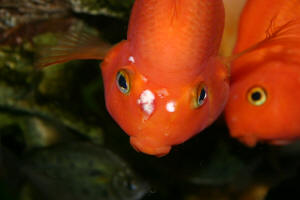
|
| Parrot Cichlid With Throat/Mouth Problem -
01/12/2006 I am Desperate to save my 9" Parrot Fish. Few
chat forums have had any idea of diagnoses. I'm left unanswered
by others because of my "hybrid." Please help me save my
best friend. I'll describe then detail. The visible problem is
his mouth. The first week it just appeared 'swollen.' No
sign of fungus or Columnaris. Just what looked like a tumor growing
inside his lower lip, swelling the outer lip, and making it hard to
eat. He (even now) is Always hungry. A forum suggested a med so I
treated the first 4 days with Maracyn (along with water changes)
and it only got worse. By worse I mean, at the end of the first
week he only had a pinhole left in his mouth that food could get
through. Smaller lumps formed on top of the larger one. I
couldn't see any fuzziness. As you can see in the pics, there
is also a small red dot on the outside of his lip. They were a
little pink/reddish in color. (he is dark orange) His fins are
lightly frayed by his gills. The dorsal and tail are healthy. I had
posted his pictures on numerous forums and no one had a clue. My
local LFS gave me Furan-2 meds and SUCCESS! Along with half dosage
of Mela-fix and decreased temp to 75F he got better. For a full 5
days the lump went down, and he was able to eat efficiently but the
lump had not completely gone away. So last night (now two weeks
with mouth problem) I increased the temp back up to 78F but still
issued Furan-2 and Melafix as usual. I figured he was getting
better and didn't want to subject his tankmates to anymore cool
waters. He was fine this morning. I come home from work, and its
Worse Than Ever. Not only is his lumpy lump almost full size again,
but he has a red pimple in the middle of his lower lip that looks
like it could pop any second. He also has stringy hairs on the
outside and inside of his mouth. Coloration and rest of body look
fine. My water conditions as of today are; Nitrites 0, Nitrates
20ppm, ammonia 0, pH 6.8, water - a little hard, temp 78F (was
75F), The tank is 55 gal. - other tankmates 1:pictus cat, 1:pleco,
1:butterfly ram, 1:gourami, 1:babyparrotfish All the fish get fed a
variety of pellets, dried krill, vegetable flakes, and tropical
crisps. The photos are from before he grew the pimple and fuzzy
hairs. I have yet to photograph his new 'state'. Please let
me know if I'm leaving any info out and PLEASE... if you have
any idea... help me save my fish =(-Jessica < Sometimes fish try
to eat things that they are not good for them. I suspect that your
parrot cichlid has an obstruction in his throat. As he tries to
expel it , the movement of the obstruction has damaged the tissue
in the area and it got infected and swollen. You treated the
infection and the swelling went down. Now the fish tried to expel
it again and has started things all over again and is swollen,
maybe reinfected. remove the fish from the water with a wet towel
and try and look down the throat to see if there is an obstruction.
Usually it is a piece of plastic plant, a filter part or an odd
shaped piece of gravel. If you do not see anything then it could be
a broken pharyngeal bone. This is a second set of jaws that
cichlids use to chew their food. Sometimes this gets broken from
pellets that are too hard to chew. I would recommend that you
presoak the fish food to soften it up.-Chuck> |
|
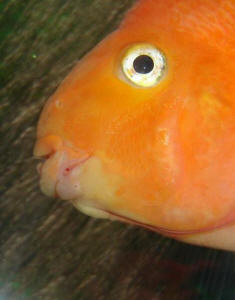 
Parrot Cichlid Problem II 1/13/06 That you so
much for the quick response. I just wanted to add a quick update. The
night I wrote that entry, I stopped administering meds and decreased
the temp back down to 75F without my usual 2-day 15% water change. I
figured, the only thing I did different before he got worse was
increase the temp. And I'm tired of medicated my other healthy
fish. The very next day... Swelling went down and the red pimple is
gone! He still has a swollen lump and outer lip, but only about 40% of
the previous days size. I was shocked! Not that he's totally
better, but it gave me much more hope. Do you think the temp decrease
had anything to do with the infection (fuzziness/red pimple) he had?
< I think the temperature reduction has lowered the fishes activity
level and it hasn't worsened the condition by trying to eat.> I
also want to check his throat out but this is the largest fish I've
ever owned and I don't want to damage his slime coat, fins or
scales by mis-handling. I hear of many people handling cichlids when
things get stuck in their mouths. I just want to know the proper and
safest way to do it. You mentioned a wet towel. Any more tips to make
sure I handle him with care? < Take a shallow pan and fill it about
half full with aquarium water. Place a towel inside the pan to absorb
the aquarium water. Take the fish out of the aquarium and place him on
the wet towel. Wrap the fish in the wet towel with just his head
exposed. Now that the fish is in control you can gently pry the mouth
open to see if there is any problems.> One more thing. If it is
something like a broken pharyngeal bone, does this ever heal? Or will I
have to deal (which I would cuz I love him) with his lump and random
infections forever? Thanks a million. You guys/gals must save a lot of
fish. YOU'RE HEROS! < The bone may heal over time with a long
term feeding program of soft mush foods.-Chuck> I have a parrot
approx 5-6 inches in length - about 18 mths old Need More
Info 5/11/07 <Hi, Jeni/Pufferpunk here> I have a
parrot approx 5-6 inches in length - about 18 mths old <Freshwater,
marine or avian?> He started with bubble fuzz on
the body and has swollen red gills and sitting on the bottom not eating
and his mouth is not open much having trouble breathing. The
local pet store gave me tetracycline and it seems to be getting worse -
any ideas? <Please post water parameters: ammonia, nitrites,
nitrate, pH. What is your water change schedule (how often,
how much)? How large is the tank/fish? Any tank
mates? There is no way we can help you without this
info. Most problems are due to poor water
conditions. Healthy tank=healthy
fish. ~PP>
|
| Parrot Cichlids With Rough Scales
5/10/07 Hi, Please help if you can. I have a 7
blood parrot fishes, and have included photographs. Please do not
mind the dirty glass.. :-) But I am currently having a slight issue
that I hope you can help me answer. I'm looking at the scales
of my fish, and am trying to remember if they had smoother scales
before. I have had a run in with dropsy in my other
tanks here about a year ago, and unfortunately, lost a
few dozen guppies and Betta fish. And noticeably, they all ended up
"pine coning" , and hope that this is not the case for my
much more larger and treasured fish. But nevertheless, here is my
dilemma, and was wondering if you guys can see if theses scales
look a bit off, for blood parrot fishes, and if you have any advice
I can use to help save them if they are indeed, not right.. Any
help, so much appreciated. Thanks Kee. < I looked at your photos
carefully and could not tell if the scales were any rougher than on
a standard parrot cichlid. Usually with bloat or dropsy the fish
stop eating and the stomach extends. If your fish are eating
normally then I think they probably fine.-Chuck> |
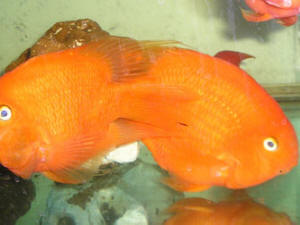
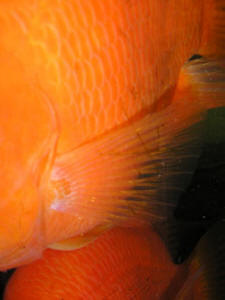 |
|
Missing scales and hurting front fin -12/14/07 Hi to all,
Your website is the most informative website on fish that I have
come across so far. I went through your fresh water disease chart
and tried to diagnose what it happening with our fish but I cant
find anything that fully matches what's happening. I have
attached the best picture I could get of the fish. <A very
nice pic> I know that you are not fond of parrotfish, but the
ones that we have we rescued from my cousin without really
knowing about the fish itself. Anyways, our largest parrot that
we have had for a year has in the last three days been losing
it's scales around it's gills and its not using it's
left front fin and the fin has a whitish look to the base of it
(lymph?) <Mmm, no> His gills seem to be curling backwards
towards it mouth a little and the fin that he is not using is
becoming frayed. Also its going lighter colored in some areas,
kind of randomly on the fish. The spots in the picture are air
bubbles that seem to be attaching themselves to him. At the
beginning we thought that it was Ick because we thought that we
saw a few little white spots on the other parrots but those spots
are gone and everyone else in the tank seems fine. Its a 72gal sumped to a extra 20 gal. below. The water is meticulously tested
and it has been up and running for a year. It has 2 404 Fluvals
w/o carbon, but with filter media and bioballs in them. There are
3 parrots 2x2.5' 1x4', 5 albino Cory cats, 2 Plecos, 1
striped cat, 5 upside down cats, and 6 little tetras.
<Surprised these haven't been consumed> The LFS that we
went to suggested to treat the tank with CopperSafe thinking it
was Ick, <No, I would NOT do this> but it's getting
worse and doesn't seem to sound like true Ick. The
temperature is 79, the PH is 7.2 and the nitrates, nitrites and
ammonia all come back low to none. The parrots get fed, Spirulina
algae flake and blood parrot pellets and blood worms, we mix up
what they get fed so they get a few variations. They get fed
every second day. Please let us know what to do with our parrot,
he's so friendly he's like a dog in the tank and I would
be very upset if we cant get him to be better. Thanks for all
your help! Carly <Is strange... but this one fish does appear
to be suffering from a "bacterial" complaint... as if
it were badly damaged... like caught, dropped on the floor... Was
this fish recently handled, netted? And with the other fishes not
suffering similar complaint... I would just do my/your best to
maintain good water quality here... and hope for the best.
Remedies will likely do more harm to the system, livestock en
toto, than good. IF you have/had another system, I might attempt
a therapy with sulfa drugs and elevated temperature, but would
NOT do this in your main display. Bob Fenner>
Re: missing scales and hurting front fin -12/14/07
Thanks for your time, he hasn't been handled at all since he
moved into the tank a year ago. We did remove the plant that the
Plecos and catfish use to hide in last weekend it wasn't
doing so well and they have taken over the parrot's cave now.
Is there a possibility that they have been attaching to him and
eating his slime coat, causing a infection? <Not likely the
"Pleco"... but what is the other catfish,
specifically?> I have heard of this happening but I
haven't seen this behaviour in our tank, at least with the
lights on and out in the open. It is on both sides of him in the
same place though, but his left side is definitely worse and
involves his front fin. His tummy seems to be sloughing off what
looks like peeling dry skin. (I only observed this after we
trapped him and separated him in the tank.) <I am going to
semi-reverse myself, and urge you to treat this Parrot... in
another established setting... at higher temperature (the low to
mid 80's F) and with a Furan compound. Perhaps
Nitrofurazone... Please see WWM re cautionary remarks,
instructions for use. BobF>
Re: missing scales and hurting front fin,
Parrot 12/18/07 Hi Bob F, Sorry about the
repetitive email but every time I come home the poor guy looks
worse. The cat fish are the upside down catfish (I don't know
if that's their technical name) and albino Cory cats.
<This Synodontis and the Corydoras catfishes are not
provocateurs here> Please see the new attached picture, the
shedding skin seems to be heading down his back. My husband
treated the main tank (AHH) with erythromycin while I was at
work, which I didn't know he was doing, will that be as
effective as your suggestion of Nitrofurazone or should we change
to that? <I would change> and is it okay to after we
already added the EM? <I would do water changes, allow some
time to cycle out, use activated carbon in your filter flow
path...> Thank you for all your helpful advice, sorry it
didn't get to me before I got home. Thanks Carly <Please
see/read on WWM re antibiotic/antimicrobial use. BobF>
Re: missing scales and hurting front fin
12/19/07 Bob, Unfortunately we had to put him down on
Saturday, it got really aggressively worse and he wasn't able
to stay under water without lying on his side and gasping :(
Thanks for all your help anyways! Carly <Thank you for this
follow up Carly. Bob Fenner>
|
|

|
|
Red Parrot 'swim
bladder' disease 4/9/08 Help <Okay> 2 years ago we
inherited a small 50 litre tank <Some teen net gallons...>
with a basic filter and 2 red parrots and 2 Plecs <... all
need more room than this> which our friends have had for years
with very few problems. After a year of huge growth they soon
out-grew their tank so we purchased a much larger 240 litre tank
with a 'proper' external filter and medium which they
seemed to prefer and more recently added another 2 red parrots
and a Gold Severum <Ahh!> 2 months later we noticed smaller
of the original red parrots (around 6" in length) became
unstable and having read up on the 'swim bladder'
condition we gave her a course of treatment. <Details please.
What sort of treatment?> This seemed to work but after another
couple of weeks the same thing was happening again. Since then we
have treated the water 3 times and done countless extra water
changes and tested the water every few days but to no avail. The
red parrot now spends most of her time floating upside-down, is
always last to the food at feeding times and constantly struggles
to maintain her balance but we seem to have tried every
suggestion given to us Do you have any ideas on what else we can
try as we sometimes feel that our only option would be to put her
out of her misery but then can't bring ourselves to do it
Mark & Sam Hewson <Mmm, well... Parrots, being neotropical
crosses as they are, do have a tendency to have orientation
issues... Particularly if raised on too-fatty foods, w/
insufficient exercise/room... Do please read here re:
http://wetwebmedia.com/FWSubWebIndex/gldfshmalnut.htm Though for
goldfish... this same "condition/syndrome" has the same
etiology and general lack of cure for Parrots. Bob
Fenner>
Re: Red Parrot 'swim
bladder' disease -04/11/08 Hi Bob <Mark and Sam>
Many thanks for getting back to us, we do appreciate it
<Welcome> We are certainly going to try putting some
'real' plants in the tank - something we were told not to
do since the fish will just destroy them but if it helps with
their health then we don't mind <There are some simple,
tough... and inexpensive "bunch plants" (listed on WWM)
that are not very palatable, that will "do" all the
things you're looking for... See here re:
http://wetwebmedia.com/PlantedTksSubWebIndex/AquariumGardenSubWebIndex.html
for Coontail/Hornwort, Elodea/Anacharis...> We will also try
the peas, etc and I had read on your website that other people
with similar problems had found that lowering the water
temperature slightly can sometimes help - this is something I did
the other evening after I e-mailed you and over the past 2 days
she seems to be moving around a lot better, albeit upside down,
but she has stopped spending so much time floating at the top of
the tank <Ah, good> The treatment that we used for the
suspected swim bladder problems was Interpet's own swim
bladder treatment which we tried 3 times with no success as well
as adding Aquilibrium Salt at the times of treatment and at every
water change as a general tonic <... not a fan of these
cathartics> I will keep you posted as to what happens with
'Perky' and let you know if she gets any
'Perkier' Mark & Sam Hewson <Thank you,
BobF>
Re: Red Parrot 'swim
bladder' disease 4/17/08 Hi Bob <Hewsons!>
With reference to our last e-mail about 'Perky' our
upside-down Red Parrot fish, despite seeming to be getting better
she died the very next day after the e-mail but we have carried
on feeding the fish a variety of different foods, flake,
bloodworm and the veggies and they seem to be ok Will check out
the website for the real plants Many thanks for all your help
Mark & Sam Hewson <Thank you for this update.
BobF>
|
|
Parrotfish Dying? Env., thermal dis. --
02/07/08 Please help me to figure out whether or not I need
to put this incredible, tough little fish to "sleep" or
not........ <Okay> I've had this parrotfish, Marvel
Ann, for over ten years now. <This is a good long while for
this neotropical cichlid cross...> She has grown over five
times her original length and is now about eight inches from nose
to tail. She's always been a feisty, funny fish and for
anyone who hasn't ever had a fish who rushes to the nearest
corner of the tank to greet you when you come in, I hope you one
day experience that! This little girl has been one of the most
personality-plus animals I've ever seen and I'm afraid
I'm going to have to euthanize her out of compassion for
her.............. I moved recently from a rental situation in
which I was living in a friend's "mother-in-law"
suite in the back of his house to my own, new house. My
friend/landlord offered to feed Marvel Ann for me while I was in
the process of getting the new house painted and ready to bring
the tank over and situation and I was over at the old place about
once or twice a week for the last month to visit and remind
Marvel Ann that she wasn't being orphaned! I arrived last
night at the old apartment and found that the heater in the tank
was HOT...the tank thermometer was registering about 93
degrees!!! It looked like the heater had malfunctioned and just
didn't turn off when it hit the 80 degree "set"
I'd had it on; the holders that keep it attached to the
inside of the tank had actually cracked and broken!!! My baby was
and is now swimming almost exclusively upside-down. She is unable
to maintain an upright position to swim, though God knows she
seems to be staying energetic enough that she keeps trying....
she'll swim along (upside down) and then go nose-to-gravel
and sort of "flip" over, only to float back to the
upside-down position. I totally freaked. I don't know how bad
this is and I don't know if I'm being cruel to not
euthanize her!!! <I would not give up hope here> I know
that my landlord has been feeding her (frozen bloodworm
"gumdrops"...4 per day) as I'd always done, so
malnutrition isn't the problem, and I brought a sample of the
tank water to the local PetSmart and they said everything looked
fine; Ph was a little low but that was all; no
nitrate/nitrite/ammonia levels to worry about. I put plastic bags
with ice cubes in the tank and cooled the water back down and got
another heater ASAP (like an hour after I found the temperature
so high!) but I'm terrified that she's been
"cooking" over some indefinite amount of time and that
she's either in "pain" (how do I find this out?) or
that her internal organs are now non-functional...I can't
imagine what to do or how to remedy this.....please! HELP! Two
different aquarium stores have told me that they doubt she's
going to "make it" and when I asked if I needed to
euthanize her, they said yes, I probably would need to. <I
disagree> One said that the most painless way was to put her
in a bag of tank water and put the bag in the refrigerator and
she'd "drop off" like she was falling asleep. The
other said to put her in a bag of tank water that had a LOT of
baking soda in it. They said this will instantly kill the fish.
<Mmm, no... not instant> I am heartbroken. This fish has
been with me for so long and responds to "contact"
better than some peoples' cats! I don't want to lose her,
but I don't want her to suffer, either. I can't imagine
whether this swimming upside-down thing is as exhaustive as it
looks or if it's just situation-normal-all-f'd-up (but
upside down!)...I put some bloodworm mix in a turkey baster and
she ate when I put that in the water up to her mouth, but I'm
pretty frantic right now.....NO idea what direction to turn
next!!!! <Calm yourself!> Thank you, for your help and for
understanding that this isn't "just" a fish, at
least not to me. It's a life, one that's touched mine,
and I want the most comfortable and humane living and/or dying
circumstances for her, just as I would want for myself. Thank you
for helping me figure out what that needs to be!!! Monica in
Dallas, Texas (United States) <I would try to be patient
here... this fish, situation may well resolve itself. There are
many instances of such spontaneous remission, following such heat
exposure. I urge patience. IF you find that you (not the fish)
cannot withstand such waiting, please read here re proper
euthanization: http://wetwebmedia.com/euthanasiafaqs.htm Bob
Fenner>
Re: Parrotfish Dying? 2/8/08
Bob! <Monica> Thank you so much for this email. I have been
unsure what to do (as is obvious!) and Marvel Ann is still
swimming upside down, but she "rests" most of the time
in the corner of her tank until she senses movement close to the
tank. <Good> Then she gets excited and wriggles her way up
to where that activity is (usually it's me just approaching
the tank!) and waits, fins frantically keeping her
"up", while I put my face or my hand next to her on the
other side of the glass. She responds when I "kiss" the
tank by coming up and putting her funny little fish lips right on
the other side! I don't know, maybe other people have fallen
in love with their fish, too, but I've had many, many pet
friends along the way (I'm 48, for God's sake, I know
this isn't typical adult behavior and I really don't give
a happy damn!) and this little fish has given me more joy than a
lot of people's precious human kids seem to!!! <I am
older... and feel the same> I talked to a vet here who said to
feed her just frozen peas; that if there was an infection that
had caused the swim bladder to not function properly then the
peas would help that out, but she's spitting the peas out
(OK, she may be more like a human kid than I'd realized!) and
mashing them up yields a lumpy sort of paste that she doesn't
seem to take in, either..... <Patience...> so I'm back
to giving her bloodworms from a turkey baster. I just don't
know how much is getting in or "through" her. I'm
not seeing anything coming out, I guess I should say. Is that
something to be worried about? <Not at present. This fish can
likely "go w/o" food for weeks...> I can't say
as I've spent any time before observing her elimination
functions and now I don't know what's "normal"
to see and what's not. I don't want her to be hungry and
I don't want her to be getting force-fed until she pops,
either! This is SO unnerving. People are saying to wait and one
person said she's seen a restaurant with a tank full of
parrotfish where one fish has swum upside-down for years. If
Marvel Ann were swimming a lot, upside down or otherwise, I'd
be more encouraged, but she's only swimming much when (as I
say) she sees me approaching and even then when she stops, she
just kind of sinks down to the bottom and bumps her nose and
eyes, etc..... I have no idea how much this hurts her, if at all.
More than anything I don't want her to be hurting or
exhausted. <Not to worry> I know this is near to impossible
to do anything about, but thank you for listening, Bob, and for
understanding how much these little guys can come to mean to
people. I do (really!) have friends on two legs that I love
greatly, too, but........there's just something about having
to make yourself learn to understand these non-verbal (though not
always non-noisy!), communicative critters that softens the heart
and makes (I think) us more human. I am calming myself, as you
said. Thanks for caring about unknown people and critters and for
helping us out. Take care and have a good day, Monica <And
you. Bob Fenner>
|
|
|

